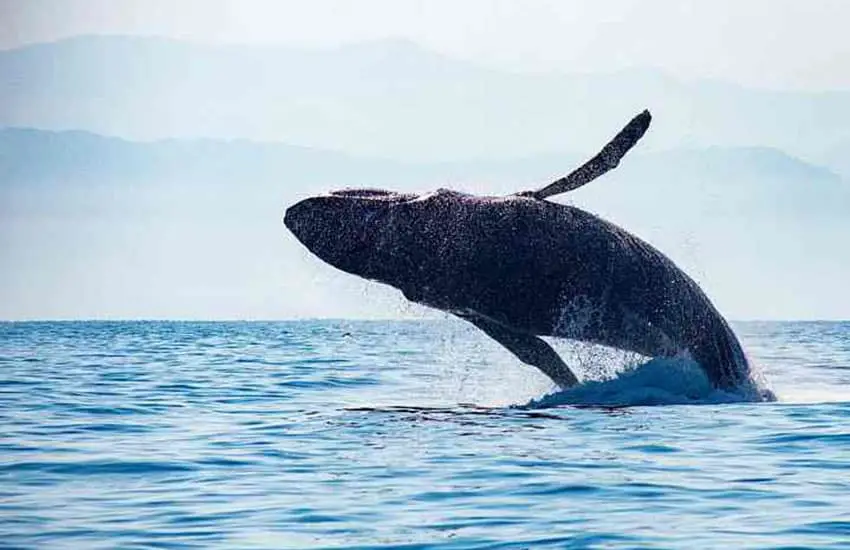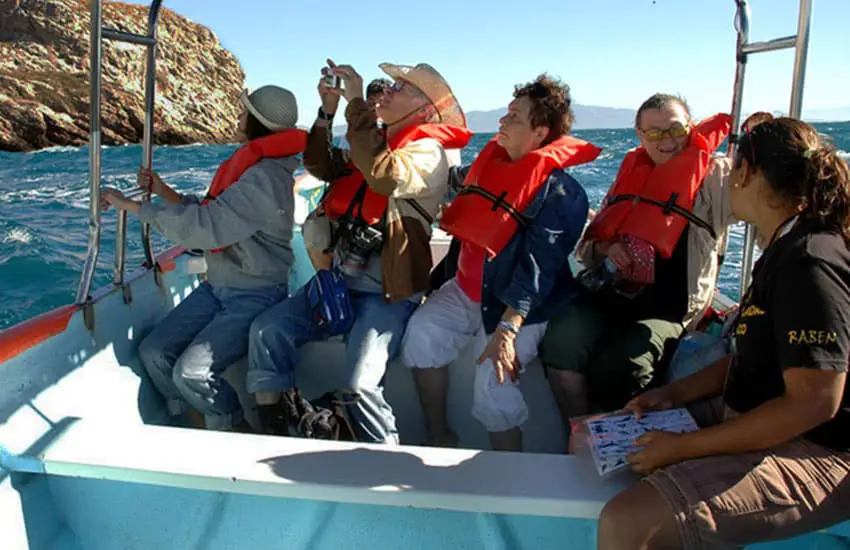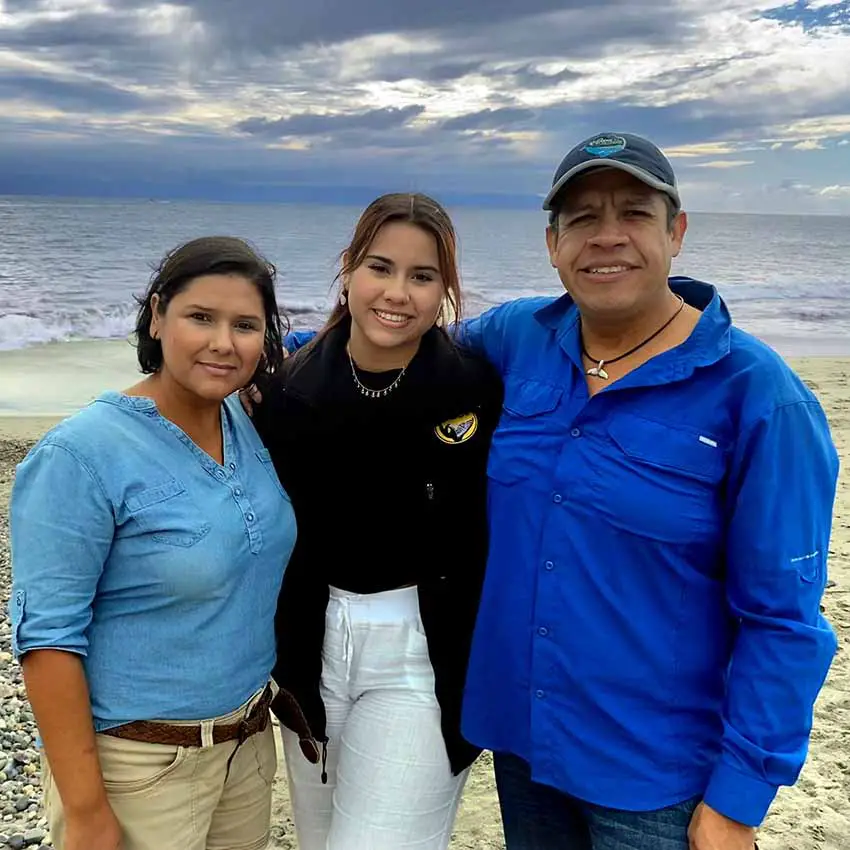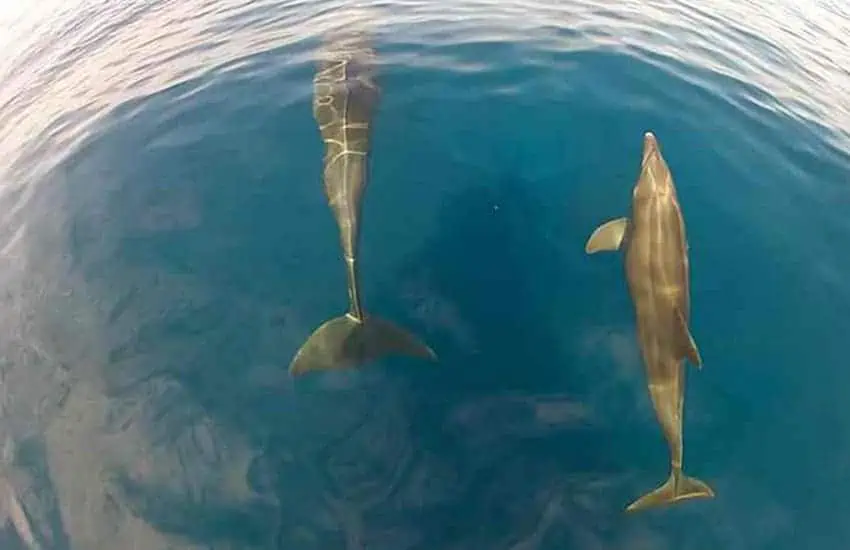Where is the best place to watch whales raising their babies? For years, I had heard it was Cabo San Lucas in Baja California, but when I put my question to friends in Guadalajara, they were unanimous:
“Puerto Vallarta is the place to go!” they replied, “and right now (January and February) is just the right time to see whales.”
So it was that I discovered Explora Vallarta, a touring company run by marine biologists. They transported my friends and me from Puerto Vallarta to the port at Punta Mita in the Bay of Banderas, where we ended up having a medium-sized boat just for ourselves, plus the pleasant company of three enthusiastic young biologists whose very lives revolve around whales.

We left the dock surrounded by brown pelicans…
“How’s the sea today?” I asked.
“Smooth,” they answered.
Well, we were soon being thrown starboard, windward, leeward and every-other-ward known to navigators of the deep as our little boat flew through the air, smacking the brine over and over. Lucky us that it was a smooth sea that day!
After half an hour, we spotted another boat, this one full of 20 lifejacket-clad tourists like us. We turned to our guide, marine biologist Jorge Morales.
“Jorge, that boat doesn’t seem to be jumping up and down like ours.”
“No,” he replied, “but that boat has almost no maneuverability. You’ll see who gets closest to the most whales.”
And so it was. Every time a head, tail or waterspout appeared, there we were, with Jorge and his wife Fabiola, explaining everything both in Spanish and English:
“Look — there’s a female humpback with her week-old baby! That baby drinks 250 liters of milk every day, and its mother eats nothing the entire time she’s in this bay because the krill she feeds on aren’t found here. She completely subsists on the energy stored in her blubber.”
“So why do they come to Banderas Bay if there’s no food here?” we asked.
“The water here is warm and calm, and there are almost no predators. You see, the baby has to come up for air every five minutes, and during this time, the mother has to teach it everything it needs to know.”
Occasionally we’d see a huge shape rise into the air and plunge straight down, slapping the water with its powerful tail.

“That’s the male,” they told us. “He accompanies the mother and helps raise the baby, even though it’s not his. He also does his best to mate with the mother.”
Our guides were a nonstop source of fascinating information, and the time seemed to fly. Suddenly our biologists told us, “That’s it for today.”
“We don’t allow boats to hang around the same whales for more than half an hour,” we were told.
Jorge had taken photos of every whale tail we’d seen and immediately filled out a register. Each tail is unique, they told us, and a computer will analyze the pictures, identify the individual whale and add this information to a large database kept in common by all the biologists in the Puerto Vallarta area.
After our excursion, I asked Jorge to tell me a little about his whale watching service.
“Fabiola and I founded Explora Vallarta in 2009,” he told me. “Both of us are biologists, and thanks to this career choice, we are forever exploring unique natural environments.”

“So, when we were students, we said, ‘Why don’t we help tourists learn about all this natural beauty, but in a responsible way?'”
The result was Explora Vallarta, a family business that benefits tourists while supporting marine biology.
“During our excursions,” said Jorge, “we collect data and take photos for identifying the whales, so we carry out very useful research while our guests are having fun.”
I learned that this family of biologists also has a very successful dolphin-watching tour, for which people come back year after year.
“We take them to visit a pod of dolphins that lives here in this bay all year round,” Jorge said. “We know where they live, but it has happened that we didn’t find them — only twice, actually, in 13 years. When we locate them, we don’t go close to them, but on most occasions, the dolphins decide to come close to us.”
They’re used to keeping quiet, he said, and to running their boat very slowly.

“Typically, it’s the dolphins that notice we are in the area and who come over to us,” Jorge said. “Sometimes they come really close, and on two occasions I have been able to reach out and touch them. In fact, sometimes they start playing in the wake our boat leaves behind, going in and out of the waves.”
Because the family has had years of experience with these particular dolphins, they can tell visitors whether they are hunting or playing or competing with one another, or perhaps teaching a youngster how to swim faster.
“We’ve identified many members of this pod,” Jorge said, “and we’ve even given them names.”
With the funds they receive from visitors, Explora Vallarta holds environmental education workshops in local schools, especially public schools, where they feel they can really impact the local communities.
“We work with kids from kindergarten to prep school, and we also hold sessions at ferias (fairs). We organize games for both adults and children, games that teach them something new,” he said.
The whale and dolphin tours also help support an organization called RABEN, the Mexican Whale Disentanglement Network, of which Jorge is a member.

“All too often,” he told me, “whales from the California coast arrive here in Mexico tangled in fishing nets. We’ve learned how to free them without danger either to them or to us.”
“RABEN started right here in the Bay of Banderas,” he added proudly, “and now we have 180 members all over Mexico.”
Want to see whales and dolphins and at the same time help marine biologists? See Explora Vallarta’s webpage. It’s in Spanish and English.
The writer has lived near Guadalajara, Jalisco, since 1985. His most recent book is Outdoors in Western Mexico, Volume Three. More of his writing can be found on his blog
